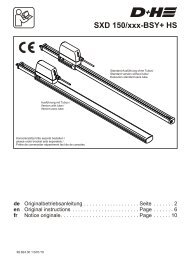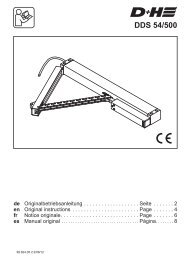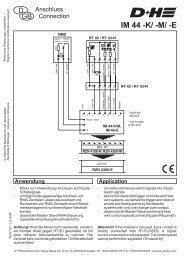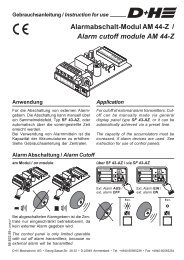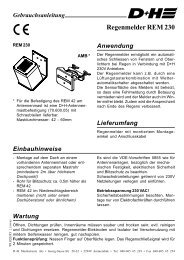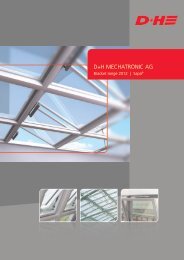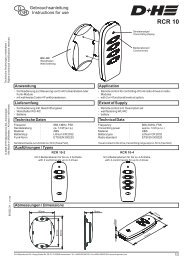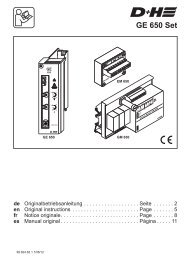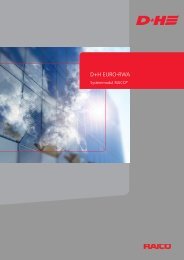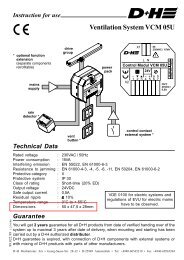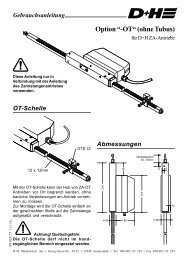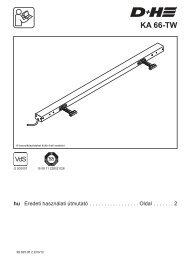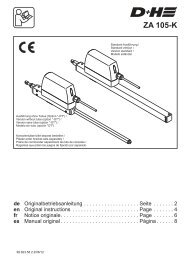Smoke ventilation according to EN 12101-2 - D+H Mechatronic
Smoke ventilation according to EN 12101-2 - D+H Mechatronic
Smoke ventilation according to EN 12101-2 - D+H Mechatronic
You also want an ePaper? Increase the reach of your titles
YUMPU automatically turns print PDFs into web optimized ePapers that Google loves.
1.3. Performance classesIn addition <strong>to</strong> some functional properties such as the opening time ≤ 60 s and requirements in accordance with<strong>EN</strong> <strong>12101</strong>-2 para. 4, the aerodynamic free area (see <strong>EN</strong> <strong>12101</strong>-2, para. 6) and specific performance classes inaccordance with <strong>EN</strong> <strong>12101</strong>-2, para. 7 are also tested.These performance classes are defined by the NSHEV manufacturer. The manufacturer may choose betweenpredefined values and the undefined class A. This chosen value is then tested by the notified test centre.The following list provides an overview of the performance classes that can be selected and the values predefinedby the standard.1.3.1. Reliability: Re class (Re 50, Re 1000, Re A) in accordance with Annex CThe reliability Re indicates how often the NSHEV can be opened <strong>to</strong> fully opened SHEV position. If the NSHEVis also intended for day <strong>to</strong> day <strong>ventilation</strong>, it must be possible <strong>to</strong> open the NSHEV at least 10,000 times <strong>to</strong> the<strong>ventilation</strong> comfort position (Le 10,000). The comfort position is defined by the NSHEV manufacturer.1.3.2. Snow load: SL class (SL 0, 125, 250, 500, 1000 N/m², SL A) in accordancewith Annex DThe snow load class SL indicates under what snow load the NSHEV can still be opened safely at ambient temperature.The snow load class is only relevant for NSHEVs in the roof. Above an angle of installation of ≥ 60°, itcan be assumed that snow loads slip off the NSHEV. Hence, snow load class SL 0 can be applied.1.3.3. Wind load: WL class (WL 0, 1500, 3000 N/m², WL A) in accordance withAnnex FThe wind load class WL indicates the suction load which may operate on the NSHEV without the NSHEV opening.For example, in dome light elements or in skylights, this should prevent the NSHEVs being opened unintentionallyby suction forces occurring on the roof. In facade exhaust systems, this is particularly important in the caseof outward opening sashes, as the suction forces may similarly cause the NSHEVs <strong>to</strong> open unintentionally.1.3.4. Low ambient temperatures: T class (T(-25), T(-15), TA) in accordance withAnnex EThe performance class T (temperature class) represents the temperature in °C at which the NSHEV has beentested and may be used. The designation T(00) indicates that the NSHEV may only be used in construction worksat temperatures above 0°C. If class T(00) applies, the NSHEV does not have <strong>to</strong> undergo a low ambient temperaturetest; in all other classes, however, this is required.1.3.5. Resistance <strong>to</strong> heat: B class (B 300, 600 °C, B A) in accordance with Annex GThe resistance <strong>to</strong> heat class B indicates up <strong>to</strong> what expected fire temperatures the NSHEV may be used.Section A15



